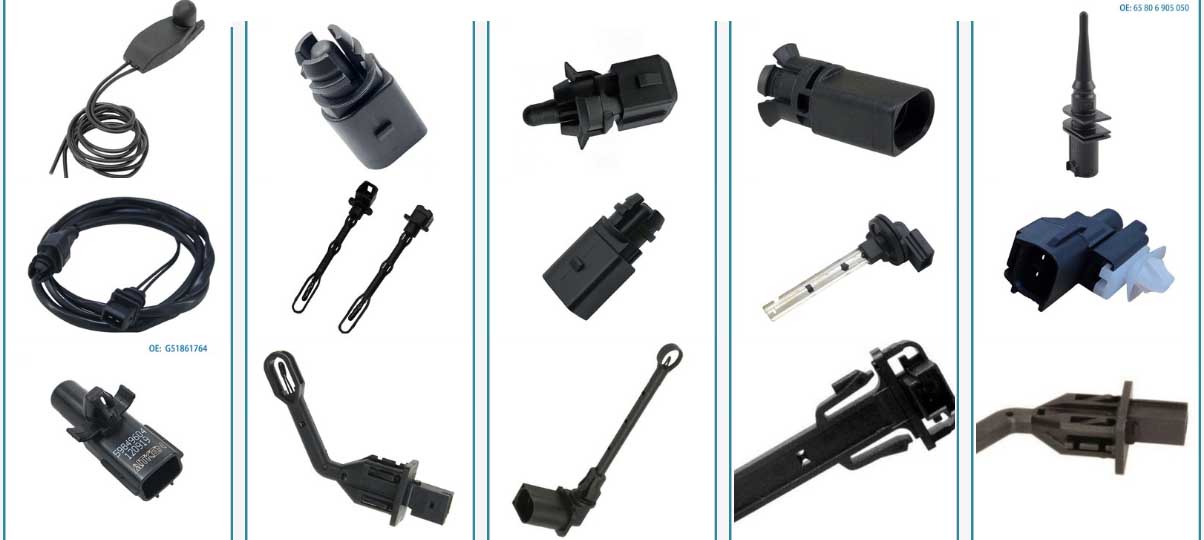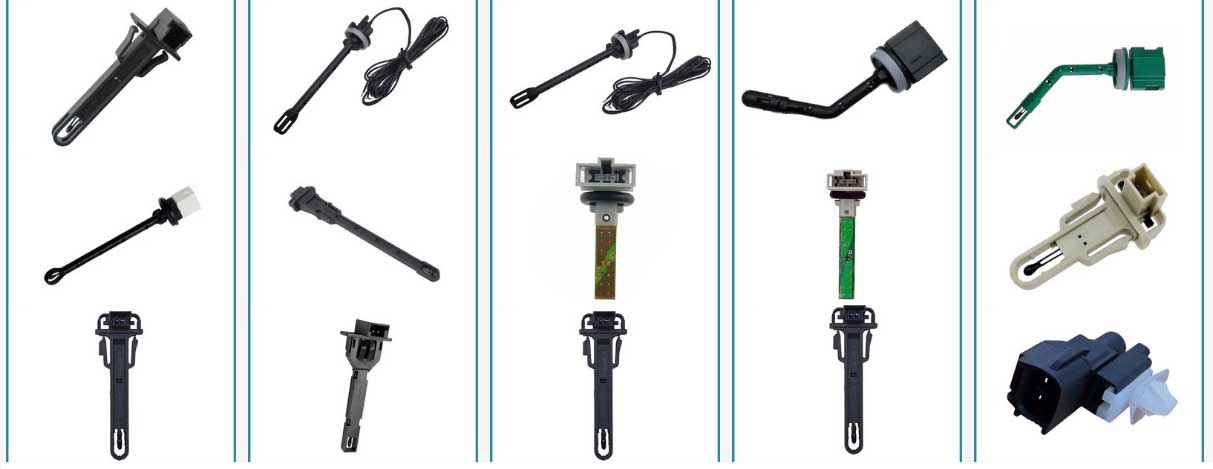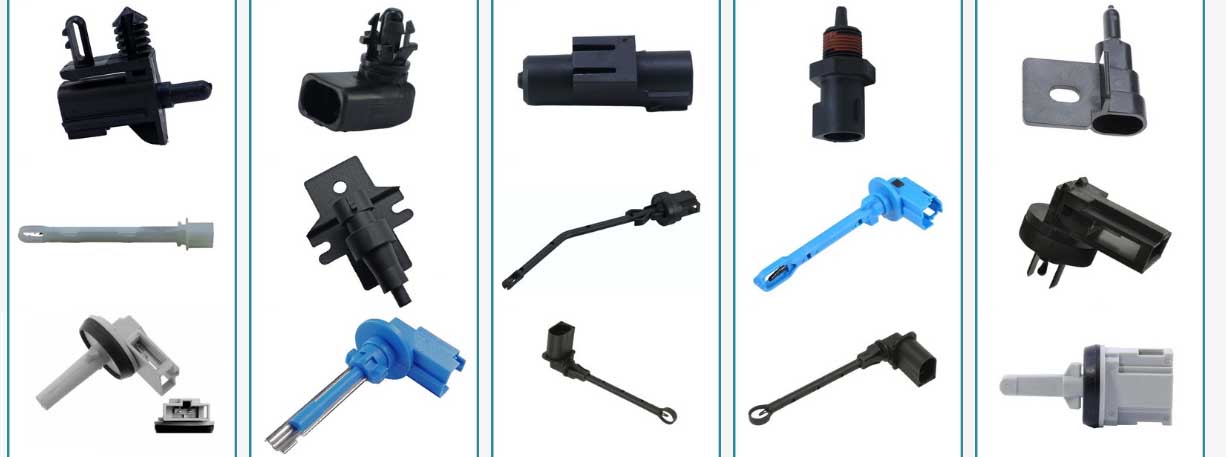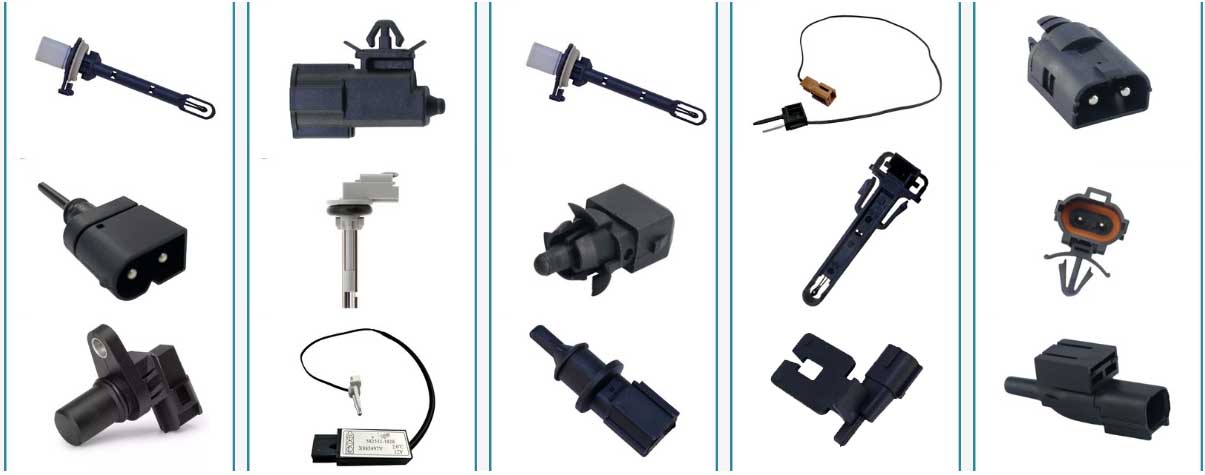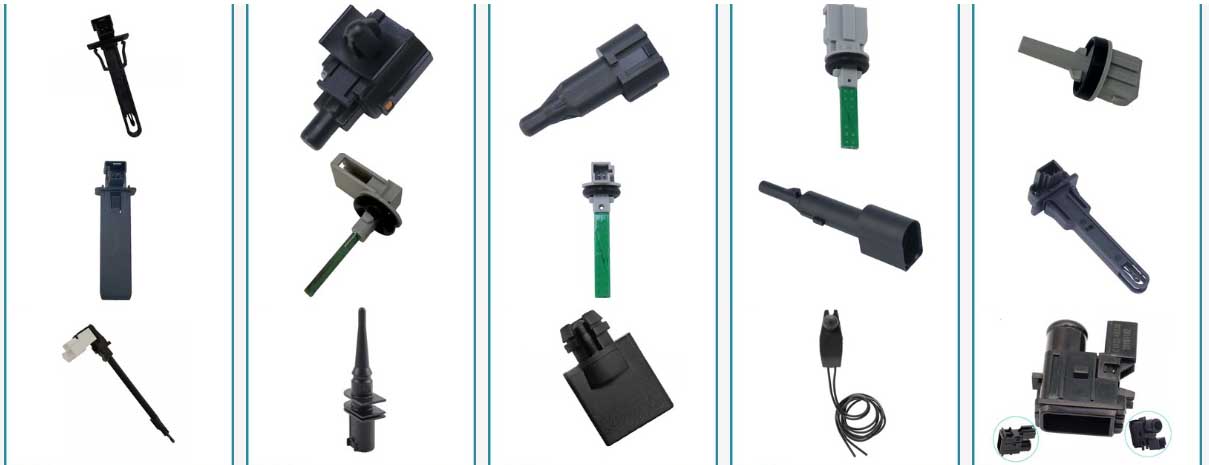تعد درجة الحرارة معلمة مهمة تعكس حالة الحمل الحراري للمحرك. من أجل التأكد من أن نظام التحكم يمكنه التحكم بدقة في معلمات عمل المحرك, درجة حرارة سائل تبريد المحرك, يجب مراقبة درجة حرارة السحب ودرجة حرارة العادم في أي وقت لتصحيح معلمات التحكم, احسب التدفق الكتلي للهواء المستنشق في الاسطوانة, وإجراء تنقية العادم.
1. مستشعر درجة حرارة سائل التبريد
درجة حرارة سائل تبريد المحرك, جهاز استشعار درجة الحرارة بالصدمة الكهربائية. تقع على الممر المائي لرأس اسطوانة المحرك, كتلة الاسطوانة أو أنابيب المياه, عادة ما يتم تثبيتها على غلاف منظم الحرارة. للمحركات التي تستخدم منظمات الحرارة الإلكترونية, يوجد بشكل عام مستشعران لدرجة الحرارة; يقع أحدهما على مبيت منظم الحرارة والآخر يقع عند مخرج الرادياتير.
يتم استخدام مستشعر درجة حرارة سائل التبريد لمراقبة درجة حرارة سائل تبريد المحرك وإرسال إشارة درجة الحرارة كإشارة درجة حرارة المحرك إلى وحدة التحكم في المحرك ECM. تنفذ وحدة التحكم الإلكترونية (ECM) التحكم التالي بناءً على هذه الإشارة.
مستشعر كشف درجة حرارة محرك السيارة
2. مستشعر درجة حرارة السحب
يكتشف بشكل أساسي درجة حرارة الهواء في مجرى الهواء ويدخل إشارة درجة حرارة السحب إلى EUC كإشارة لتصحيح توقيت حقن الوقود والإشعال. مثبت بشكل أساسي على خرطوم السحب الخاص بفلتر الهواء ومستشعر تدفق الهواء.
مستشعر كشف درجة حرارة الهواء الداخل للمحرك
3. مستشعر درجة حرارة زيت ناقل الحركة
كلما ارتفعت درجة الحرارة, كلما انخفضت المقاومة. يقوم الكمبيوتر بقياس درجة حرارة الزيت الهيدروليكي لناقل الحركة الأوتوماتيكي حسب تغير مقاومته, والذي يستخدم كأساس للكمبيوتر لإجراء التحكم في التحول, التحكم في ضغط الزيت والتحكم في قابض القفل. مثبتة على لوحة الصمام داخل وعاء زيت ناقل الحركة الأوتوماتيكي, أنه يحتوي على الثرمستور أشباه الموصلات مع معامل مقاومة درجات الحرارة السلبية.
4. مستشعر درجة حرارة العادم (مستشعر درجة حرارة المحفز)
الاسم المستعار: مستشعر درجة الحرارة التحفيزي, وتتمثل المهمة الرئيسية في إرسال إشارة إنذار بسرعة عندما يتم تسخين المحول الحفاز بشكل غير طبيعي, وذلك لحماية المحول الحفاز ومنع الأعطال الناجمة عن ارتفاع درجة الحرارة. يتم تثبيت هذا المستشعر بشكل أساسي خلف محول المحول الحفاز.
5. جهاز استشعار درجة الحرارة لمراقبة تداول غاز العادم EGR
يقوم مستشعر درجة حرارة مراقبة EGR بالكشف عن درجة حرارة غاز العادم المعاد تدويره في نظام EGR للتأكد من أن النظام يعمل بشكل صحيح. تقليل محتوى مركبات أكاسيد النيتروجين والكبريت والغازات الضارة الأخرى في عوادم السيارات.
قياس درجة حرارة خط أنابيب الصمام, جهاز استشعار درجة الحرارة للكشف عن انبعاثات العادم
6. مستشعر درجة الحرارة الخارجية
يُسمى مستشعر درجة الحرارة الخارجية أيضًا بمستشعر درجة الحرارة المحيطة, وهو عنصر استشعار لنظام التحكم الآلي في تكييف الهواء. عادةً ما يتم تثبيت مستشعر درجة الحرارة الخارجية على حامل تثبيت المصد الأمامي وهو أيضًا مقاوم حراري. وظيفتها هي الكشف عن درجة الحرارة خارج السيارة. سيحدد نظام التحكم طريقة التحكم بناءً على الفرق بين درجة الحرارة الخارجية ودرجة الحرارة الداخلية. على سبيل المثال, عندما تكون درجة الحرارة المحيطة أقل من 5 درجات مئوية, سيقوم نظام التحكم في تكييف الهواء بفصل مصدر طاقة قابض الضاغط وإيقاف نظام تبريد تكييف الهواء.
7. مستشعر درجة الحرارة داخل السيارة
يعد مستشعر درجة الحرارة داخل السيارة أيضًا أحد عناصر الاستشعار في نظام التحكم التلقائي في تكييف الهواء. يتم تثبيته عادةً في الجزء السفلي من لوحة القيادة وهو عبارة عن ثرمستور بمعامل درجة حرارة سلبي. سوف تنخفض مقاومة الثرمستور تدريجياً مع زيادة قيمة درجة الحرارة. وتتمثل وظيفته في اكتشاف ما إذا كانت درجة الحرارة داخل السيارة تصل إلى القيمة المحددة للتحكم في تشغيل نظام تكييف الهواء.
8. مستشعر درجة حرارة ضوء الشمس
يتم تثبيت هذا الجهاز بشكل أساسي عند مخرج الهواء لمكيف الهواء لاكتشاف تغير درجة الحرارة على سطح المبخر للتحكم في حالة عمل الضاغط.
9. جهاز استشعار درجة الحرارة الثرمستور
يتم التحكم في مروحة تبريد الرادياتير وفقًا لإشارة درجة حرارة سائل التبريد ويتم تثبيتها على قناة دوران سائل تبريد الرادياتير.
10. مستشعر درجة حرارة مخرج مكيف الهواء
يتم تثبيت مستشعر درجة حرارة مخرج المبخر على لوحة المبخر لنظام تكييف هواء السيارة لاكتشاف تغير درجة الحرارة على سطح المبخر والتحكم في حالة عمل الضاغط. عند العمل, يقوم مستشعر درجة حرارة مخرج مبخر مكيف الهواء بالكشف عن إشارة درجة الحرارة على سطح المبخر وتحويلها إلى إشارة كهربائية وإدخالها إلى وحدة التحكم الإلكترونية في نظام التحكم في درجة الحرارة. بعد أن تقوم وحدة التحكم الإلكترونية بمقارنة إشارة درجة حرارة الإدخال مع إشارة ضبط درجة الحرارة المحددة, فهو يتحكم في تشغيل وإيقاف القابض الكهرومغناطيسي لضاغط مكيف الهواء, وبالتالي التحكم في تشغيل الضاغط. في نفس الوقت, يمكن أيضًا استخدام إشارة درجة الحرارة التي اكتشفها هذا المستشعر لمنع انسداد الجليد في المبخر.
 English
English Afrikaans
Afrikaans العربية
العربية বাংলা
বাংলা bosanski jezik
bosanski jezik Български
Български Català
Català 粤语
粤语 中文(简体)
中文(简体) 中文(漢字)
中文(漢字) Hrvatski
Hrvatski Čeština
Čeština Nederlands
Nederlands Eesti keel
Eesti keel Suomi
Suomi Français
Français Deutsch
Deutsch Ελληνικά
Ελληνικά हिन्दी; हिंदी
हिन्दी; हिंदी Magyar
Magyar Bahasa Indonesia
Bahasa Indonesia Italiano
Italiano 日本語
日本語 한국어
한국어 Latviešu valoda
Latviešu valoda Lietuvių kalba
Lietuvių kalba македонски јазик
македонски јазик Bahasa Melayu
Bahasa Melayu Norsk
Norsk پارسی
پارسی Polski
Polski Português
Português Română
Română Русский
Русский Cрпски језик
Cрпски језик Slovenčina
Slovenčina Slovenščina
Slovenščina Español
Español Svenska
Svenska ภาษาไทย
ภาษาไทย Türkçe
Türkçe Українська
Українська اردو
اردو Tiếng Việt
Tiếng Việt

